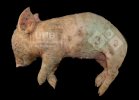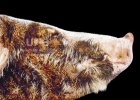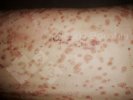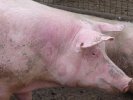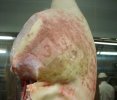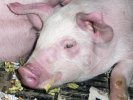Mange
Mange is a skin disease caused by an external parasite (mite) which is characterized by severe swelling which affects pig growth.
Alternative names: Sarcoptic mange, Sarcoptes scabiei, scabies
Information
Mange is a parasitic skin disease caused by Sarcoptes scabiei. It is not common to find mange caused by Demodex phylloides in swine. Sarcoptic mange (sometimes called scabies) is the most common and it is significant because it is irritating and uncomfortable to pigs, causing a lot of scratching and skin damage. It significantly reduces the growth rate and feed conversion rate. The life cycle of the mite is short, taking 14-15 days to complete. The mite dies quickly away from the pig. In less than five days in most conditions (although it could be from hours to 15 days). It is important to keep this in mind for its control. If a farm is free of mange, it is one of the easiest diseases to prevent, because it can only be introduced to the farm by animals carrying the organism. However, once introduced into the farm, it tends to remain endemic if measures are not taken.
Symptoms
With acute disease:
- Pigs shake their ears.
- They scratch continuously against the walls of the pen. About three to eight weeks after the initial infection, the skin becomes sensitive to the protein of the mite, and animals can develop an intense allergy resulting in small, red spots covering their entire skin.
- Severe itching can cause the animal to scratch to the point of drawing blood.
- Small, red dots all over the skin.
With chronic disease:
- Thick, asbestos-like lesions appear on the ears, both sides of the neck, the elbows, the front of the hock and the dorsal part of the neck.
- Affects the feed conversion rate and daily gain, especially in the case of a severe infection.
Causes / Contributing Factors
- Mites spread directly from pig to pig, either through skin contact or contact with recently contaminated surfaces.
- The boar contributes to the persistence of the infection on the farm because he is constantly in direct contact with the skin of breeding females and remains a chronic carrier.
- If pigs are housed in groups, spreading is easier.
- Purchase of infected pigs.
- Using pens continuously.
- If no control measures are taken or no treatment is given, it will result in a serious problem.
Diagnosis
Diagnosis is confirmed by demonstrating the presence of the mite. Scrapings are taken from suspicious skin lesions, especially from inside the ears. A teaspoon can be used to collect a sample from inside the ear. Mites from scabies may be seen by the naked eye; they are round and 0.5 mm in length. To visualize the mites, place the material collected from the ear on a piece of black paper and leave it there for ten minutes. There is also an ELISA test available to perform blood tests, although its use is not common.
Control/Prevention
Mange is an expensive disease, not only because of its economic impact on pigs, but also due to the cost and need for repeated treatments and damage to farm equipment.
Adult population
- Examine the breeding animals looking for chronic lesions. Identify these animals so that they receive special treatment. These chronic lesions, which are mainly found in the ears and behind the elbow and limbs can be difficult to treat and remain a constant source of infection.
- Treat all breeding animals (gilts, sows, and boars) with phoxim. Repeat treatment after 10-14 days. Alternatively, use ivermectin or injectable doramectin, or feed ivermectin every 4-6 months.
Weaned pigs
- Treat pigs the day of their weaning with phoxim orally or give an injection of ivermectin. Alternatively, medicate the pre-starter with ivermectin for 7 days or put it in the water during the first five days post-weaning. The second option is better if you use a water tank attached to the bowl type drinker. Ivermectin has given good results when dipping animals.
- The treated pigs should be moved to clean pens that have been sprayed with an anti-parasitic substance such as amitraz and left empty for a minimum of three days, but preferably five or six days.
- If scabies is active at the beginning of the growing phase, add ivermectin in the feed for seven days.
- There are effective eradication programs using injections of ivermectin or doramectin as well as cleaning and fumigating every pen and corridor.

